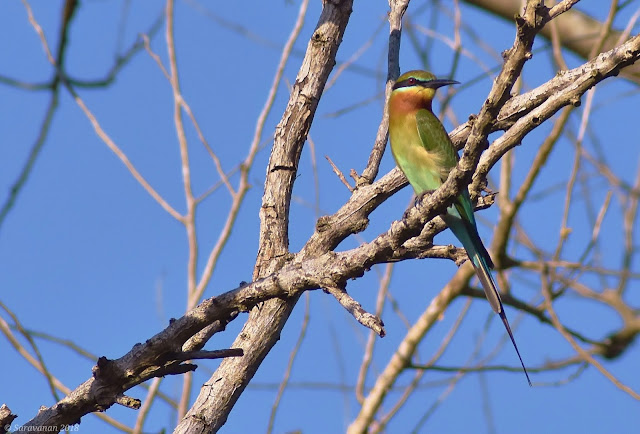I came back to Jalan Kebun, and its another hot day as well. I again went to the big dead tree looking for kingfishers, but bumped with a pair of Blue Tailed Bee-eater. They are quite near to me, so I decide not to move too much. This was the time I tested to shoot in manual mode and it really give good result instead of fully depending on the camera's auto settings. I can say Blue Tailed Bee-eaters are not that common in the northern states since I didn't even find a single bird in Perak. Blue Throated Bee-eaters are much common there.
 |
| Blue Tailed Bee-eater (Merops philippinus) |
 |
| Blue Tailed Bee-eater (Merops philippinus) |
Bee-eaters are known as "Panchuruttaan" (பஞ்சுருட்டான்) in Tamil. Since they look like a bow and arrow during their flight, they carry the Sanskrit name, which means "Vishnu's Bow. According to the Malaysian folklore, Bee-eaters are often associated with a ghoul, locally called as "Hantu Tinggi", literally means "Tall Demon" in Malay. Bee-eaters are used as an indicator for incoming thunderstorms by the locals as well.
 |
| Blue Tailed Bee-eater (Merops philippinus) |
Then I found a White Throated Kingfisher perching on the dead tree as well. I had the difficulty to place myself well since so many dead twigs blocking my view. There were a pair of Common Ioras too perching on the same tree. I had a tough time to focus on it since its quite a distance for a small bird.
 |
| White Throated Kingfisher (Halcyon smyrnensis perpulchra) |
 |
| Common Iora (Aegithina tiphia) |
 |
| Black Naped Oriole (Oriolus chinensis diffusus) |
 |
| Spotted Dove (Spilopelia chinensis tigrina) |
 |
| Zebra Dove (Geopelia striata) |
I manage to get a shot on a male Scarlet Backed Flowerpecker, while it was having its breakfast on a Jamaican Cherry Tree. I was pretty close to it and manage to take the shots, since it would be troublesome for me to manage with such a small and fast moving bird in a far distance. Its feeds on the cherries in a similar way that it feeds on the mistletoe fruits (
Dendrophthoe pentandra); it squeezes out the pulp and eats it, then the skin is thrown away.
 |
| Scarlet Backed Flowerpecker (Dicaeum cruentatum) |
It was indeed a fruitful day. I will be back to this spot for more photos.










No comments:
Post a Comment